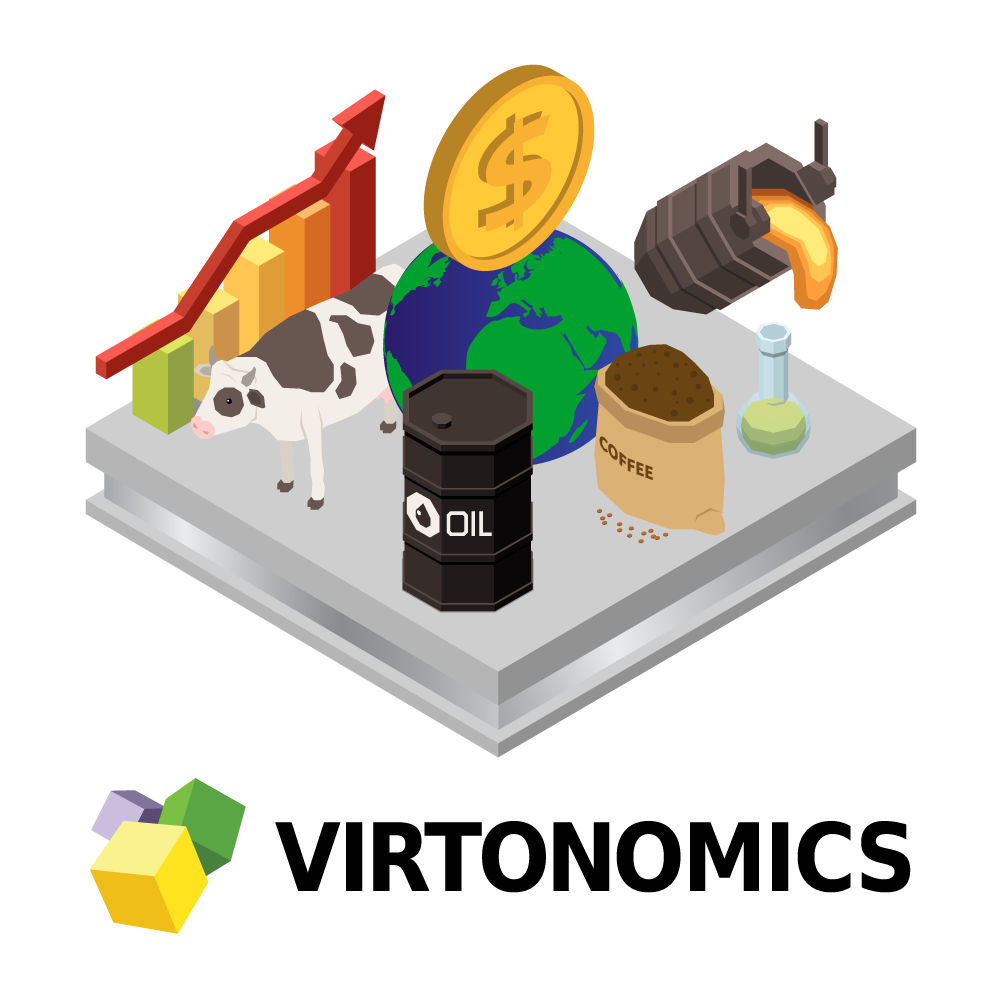
- How to play the economic strategy game Virtonomics?
- What is the game about and what can you do here?
- What is a turn-based economic strategy game?
- What is multiplayer economics simulation?
- What is a free business game scenario?
- Recommendations for a beginner
- Complete the starting tasks – “Quests”
- Start developing retail business
- Explore the main sections of the game menu
- Business skills
- Initial qualification and its growth
- Summary: what to do first
- What to do after the first turns?
- Other important and useful information:
- Boosters and innovations
- Reports
- The most important financial indicators
How to play the economic strategy game Virtonomics?
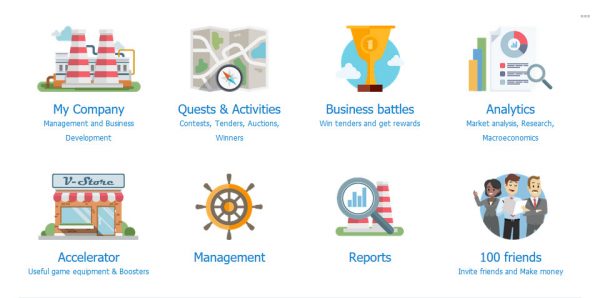
What is the game about and what can you do here?
Virtonomics is a turn-based multiplayer economic game where you create and manage your company and build your business empire.
Your main goal in Virtonomics is to build a large competitive company that dominates the global market.
In our virtual but realistic economic space, you manage your own business, competing with many competitors. Your company may include a variety of divisions – natural resource enterprises, factories, shops, restaurants, research centers, and much more. During the game, you can create a wide variety of business units and try to develop your business in any industry and any market.
In each division of your virtual company, you manage all key business processes and functions: HR, production, marketing, sales, logistics, strategic management, finance, purchasing, etc.
The model of economy and market behavior in the simulation is based on the most advanced stochastic modeling methods, using big data on the results of the actions of hundreds of thousands of players. The behavior of the virtual economy and the dynamics of industries and markets in our simulation is formed and changed as a result of the actions and behavior of many players who build their virtual business and interact with each other. Such an economic model is as realistic as possible and close to the behavior of markets in real life.
What is a turn-based economic strategy game?
Each game round lasts one day. During the day, you can enter the game at any convenient time to manage your company. At the end of each round, the game situation is updated, during which the server calculates the results of all actions and transactions that all players have made during the day. After the “server recalculation” is completed, a new round of the game begins, in which you can see the results and consequences of all your managerial decisions in the previous round. And in the new round, you can continue to develop your business empire. The number of game rounds is not limited. Many players have been playing Virtonomics for several years. For a one-day game round in the virtual game space, a week passes. Each round ends at the same time for all players. You can see the counter of time left until the end of the round in the upper right corner.

Information in the timing line: game date / current server time / time before recalculation
What is multiplayer economics simulation?
This means that you are not playing with bots and static algorithms but with thousands of live players from all over the world. It is real people who will be your competitors, partners, suppliers, and customers (except retail buyers). Everything is almost like in real life!
A unique feature of Virtonomics is that the economic space of the game world changes dynamically and does not have a predetermined algorithm. Thousands of players through their actions affect the state of virtual markets and economies that change, and therefore also affect the behavior of our players. All this creates a realistic market environment, which is characterized by risk and uncertainty.
What is a free business game scenario?
Our economy simulation game doesn’t have a linear scenario. This is an open world of economics and business. As in real life, you set intermediate goals for yourself, come up with a strategy to achieve them yourself, and develop your path to dominance in global markets. You can build your business in any of the 200 available industries (retail, services, manufacturing, energy, agriculture, etc.), in any of several dozen countries. You can also focus on research and development of new technologies, or participation in politics and regional governance. You can create your party, and become the governor or president of the country. Your possibilities are not limited. Experiment, and look for your path to the heights of success.
This form in the “My Company” menu will help you describe your business model and strategy:
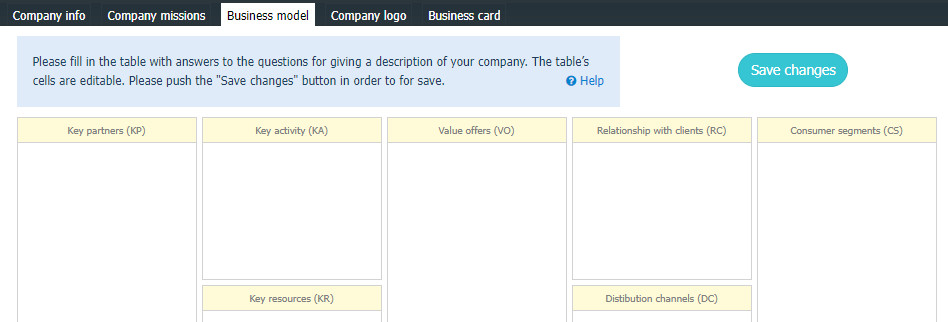
Recommendations for a beginner
Complete the starting tasks – “Quests”
Since Virtonomics is the most realistic economic simulation with very extensive gameplay, without a clear sequential scenario, the game may seem complicated and incomprehensible to you at the very beginning. At first, you may be confused by the variety of possibilities, an unusual interface with a large number of numbers, and most importantly, you do not immediately understand the answer to the question – “What can you do here and how to start the game?”. We hasten to reassure you, we have tried to simplify the process of getting to know Virtonomics and the world of big business. First of all, we recommend that you pay attention to the “Quests” section.
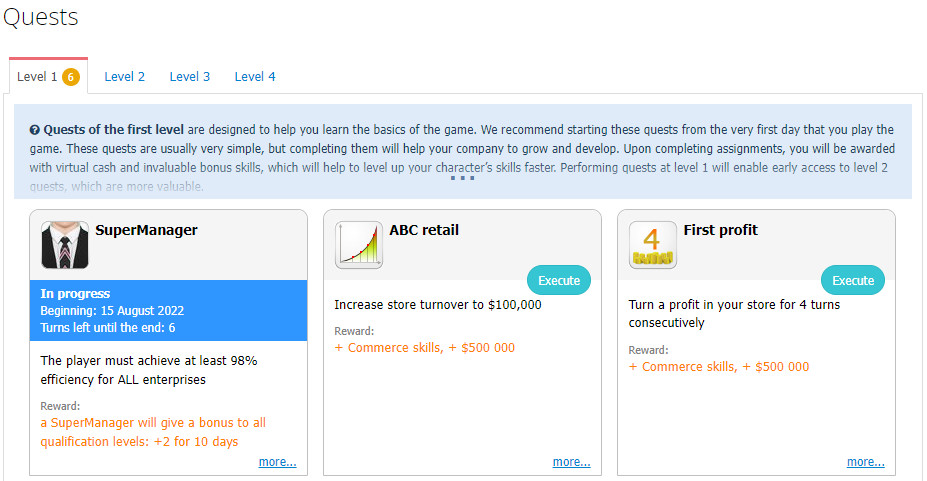
Completing quests will allow you to quickly understand the interfaces and basic game mechanics. At the beginning of the game, tasks will become key short-term goals for you in the game.
Start developing retail business
While a wide range of different industries are available to you from the start, your initial capital is limited. Therefore, so that you do not go bankrupt quickly, we recommend that you try the retail business first. Build and make several shops successful. After that, you can move on to a more costly manufacturing business.
The store is the only type of business unit where your customers are bots. In all other enterprises (factories, farms, mines, etc.), real people act as buyers, players just like you.
An example of displaying a line with a store on the main page of an enterprise:

Hover your cursor over store indicators and the simulation will give you hints about location, line of business, core products, and key performance characteristics.
The business model of the store is simple: buy cheaper (from the supplier), sell more expensive (to the consumer). Profit should cover the costs of maintaining the store (rent of retail space, staff salaries, advertising costs, etc.) and the purchase of goods.
Explore the main sections of the game menu
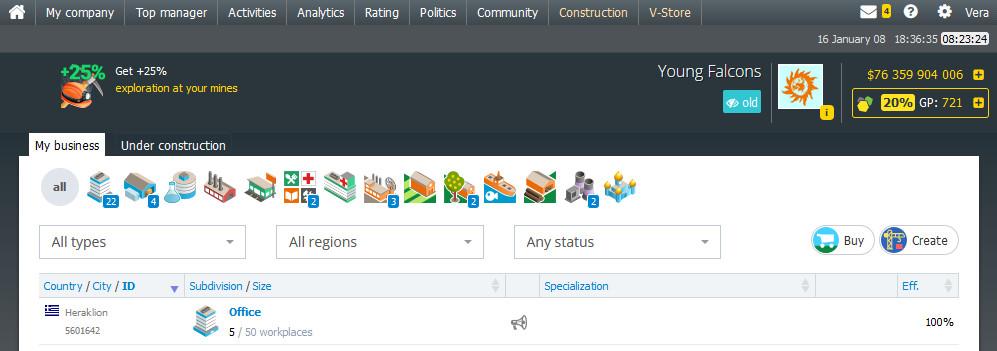
MY COMPANY:
Enterprises: an overview of all enterprises, opening new subdivisions.
Reports: financial, market reports; reports based on specific products, technology sales, warehouse stock, and logistics.
Management: equipment, technologies, licenses, business boosters.
Strategy: participants can define their business strategies, business models, and company goals.
TOP MANAGER: the qualification level of a participant in specific business fields.
ACTIVITIES: game missions, tasks, contests, tenders.
ANALYTICS: the information about the virtual economics world:
Market analysis: reports on the products, competitors, geographical locations, licenses, production, etc.
Macroeconomics: geographical map of the virtual environment, logistics and transportation expenses, seasonality.
Reference: the list of industries and enterprises, business boosters, and trade.
Bonuses and restrictions: taxes and fees, demographics information, etc.
RATING: lists and ratings of the best players and companies in many different categories.
POLITICS: organization of political parties, elections of mayors, governors, and presidents.
CONSTRUCTION: Build unique structures and wonders of the world.
Business skills
The experience and business skills of a top manager have a direct impact on the efficiency of the office and enterprises. Click the “Top Manager” menu section and you will see the current skill values of your game character.
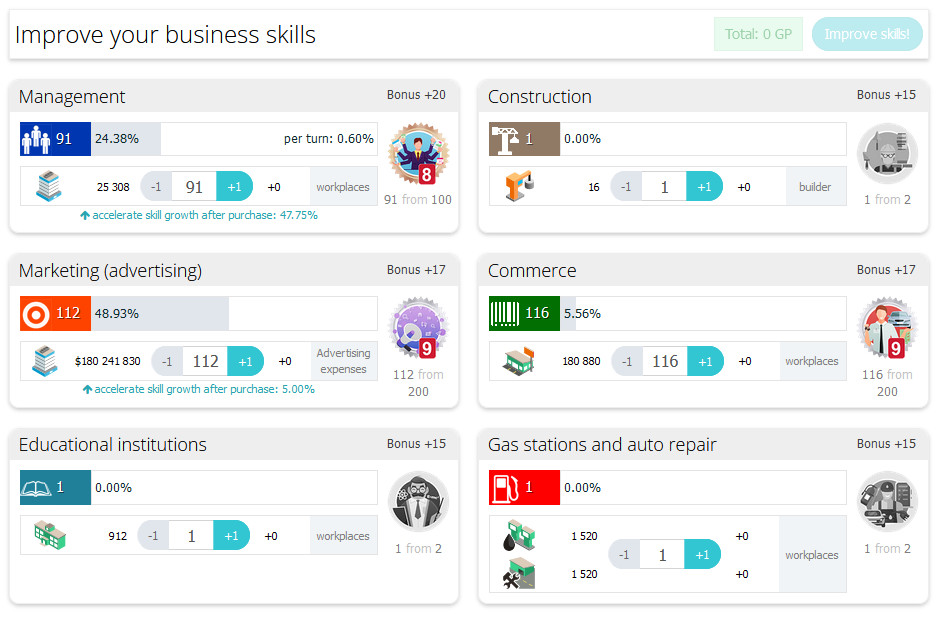
The higher your skills in a certain field is, the bigger and more hi-tech enterprises you will be able to manage. If the qualification level is not high enough, the efficiency of your business decreases, which leads to bigger expenses and lesser profit.
Initial qualification and its growth
The qualification level that you receive at the start of the course depends on the purpose of the course. Normally, the initial qualification is relatively high (e.g., 10 or 20), for short-term courses and training and relatively low (1-5) for long-term ones.
Your skills will be growing steadily if your business is profitable.
Summary: what to do first
- Analyze the markets in which your company operates. Identify those goods and raw materials that have the greatest sales prospects. Focus on these products.
- Find a promising market for your company based on market size, level of competition, and other indicators. Don’t forget to open the office first. Without it, as a management structure in the region, no other unit can function.
- Make purchases of promising goods (raw materials). Take into account factors such as the location of the division, the average price, quality, and brand of products in this market, and the sales volume of competitors.
- Set selling prices for your products.
- Check that all your departments are provided with personnel, production equipment, and contracts for the purchase of components or goods.
- Try to complete most of the starting tasks.
What to do after the first turns?
- Check the efficiency of all your subdivisions on the homepage.
- Take advantage of the in-game hints.
- Look at the company financial reports — that way you can see which subdivisions of your company are more profitable.
- Check the sales volumes in the trade hall and the warehouse of your factory are all products selling out? How many units were ordered and how many were sold? Experiment with prices if necessary.
- Improve the sales and leftover stock supplies. Bear in mind that there is no point in investing in products that are not selling out.
- Launch an advertising campaign. Try various advertising channels and budgets. Increase the efficiency of the advertising campaign.
- Expand your business — optimize the processes in existing subdivisions or open new ones.
Other important and useful information:
Boosters and innovations
Economic game Virtonomics has the function, can accelerating certain business indicators using business boosters, like opening parking spaces, launching ERP business management systems, integrating quality control, increasing energy efficiency, etc. Every business booster has its price, service costs, and validity.
Boosters for stores:
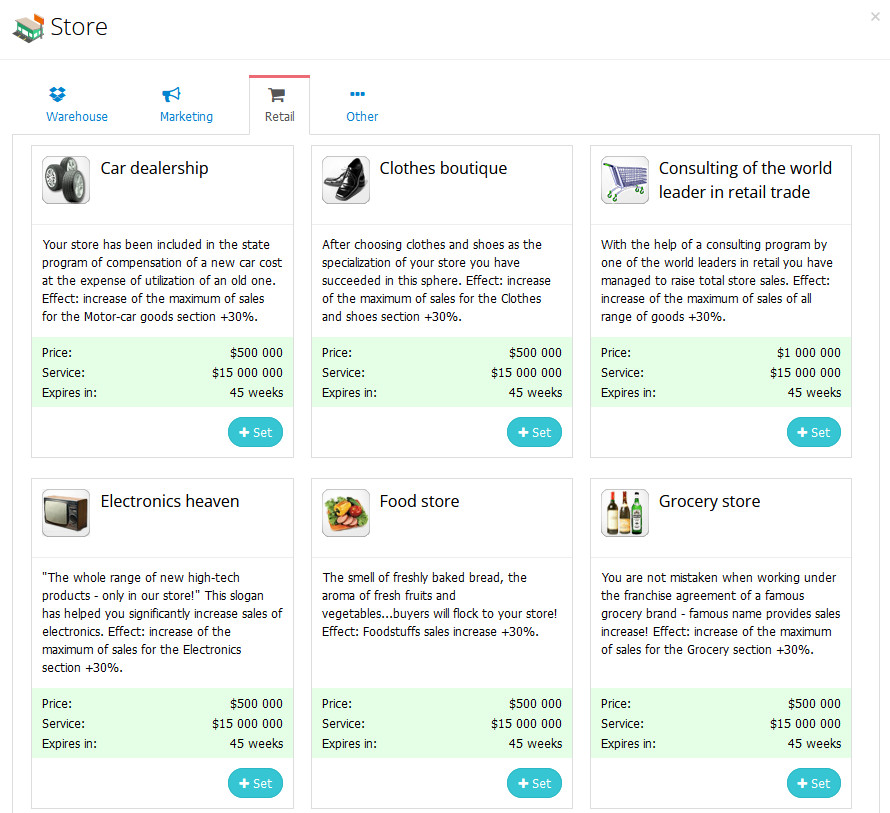
Innovations for factories:
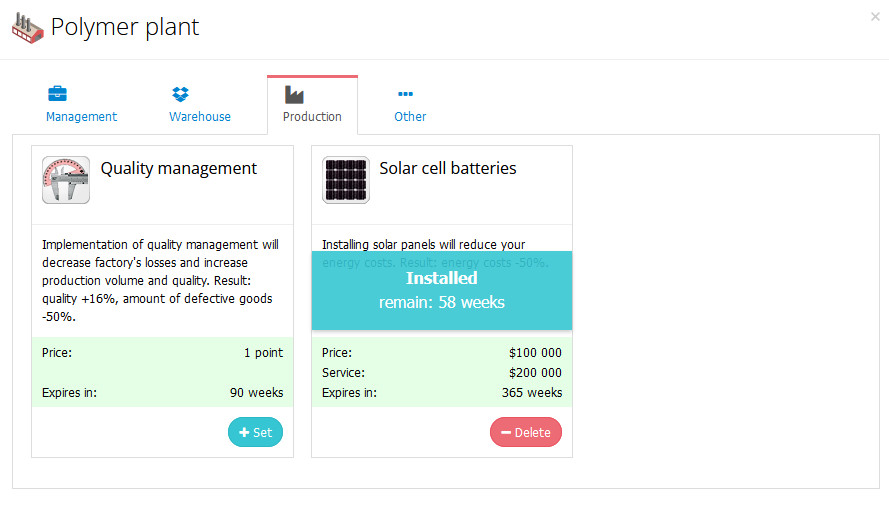
Activating boosters
Go to the main page of a subdivision. Click on the buttons at the top of the page.
Select the ones that would match your enterprise and would be effective in accelerating your business.
For example, if your qualification in management is quite high, but your store still cannot attract high traffic of customers (although the size of your store is good, the ad campaign is effective, but the store efficiency is still not 100%), so it is better to invest in convenient parking space rather than in installing EPR system.
Information on boosters is available by clicking on «Analytics » – «Reference» – «Business boosters» tab.
Reports
For reports of your company click on «My company» > «Reports». There are a lot of different types of reports. Financial reports, for instance, show the financial indicators of your company: revenues, expenses, profit, and indicators based on regions, subdivisions, products, etc. There are marketing, warehouse, and movement of goods reports as well as technology and mineral deposits reports. You can also see the reports of each subdivision of yours in the «Financial Report» tab.
A sample of a financial report of the store, which has been opened only a few game turns before:
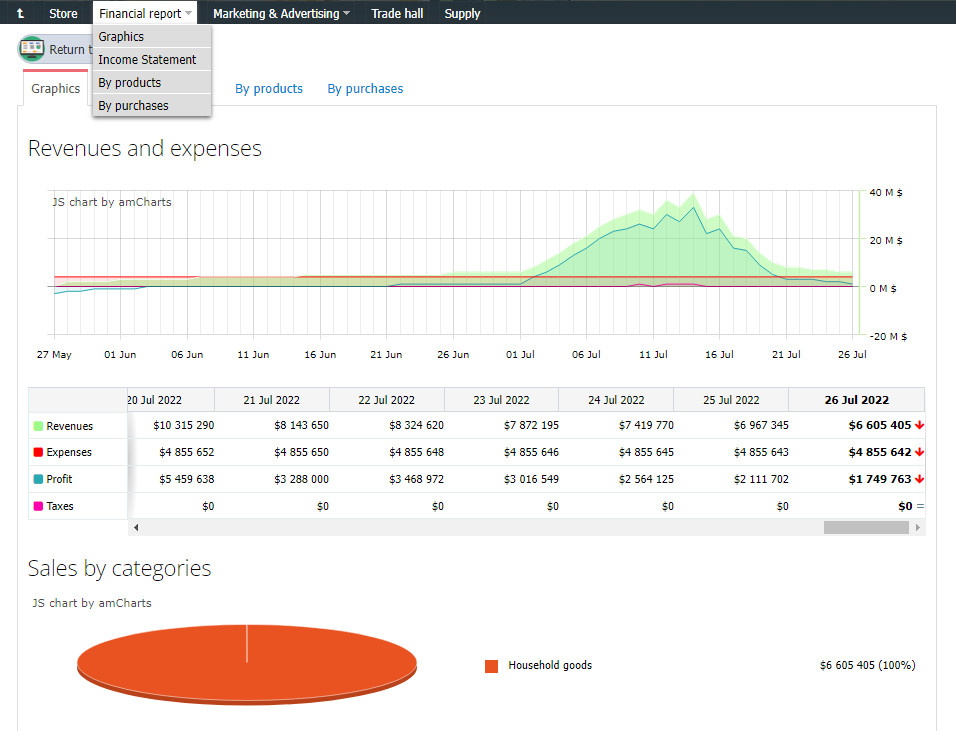
Your money balance is seen together with your name in the top corner of the homepage:

The most important financial indicators
Just like in real business, virtual companies have a lot of important indicators. But there is the most important that should be taken into consideration in the first place:
Money balance — it is your strategic recourse for opening new subdivisions, purchasing supplies, and equipment, paying for ad campaigns, salary to your employees, rent, etc. Bear in mind that your money resources are not unlimited and excessive investment in products may eventually tie up your money. Poorly calculated expansion or financing of expensive projects can lead the company to bankruptcy as well. All operations of a bankrupt company are
put on hold.
Profit — an indicator of your success, which helps you save money. This indicator is a difference between the revenues and expenses of your company.
Revenues and expenses — open several subdivisions that would generate stable profit. Try to decrease your expenses, while increasing your revenues. Do not expand your business without conducting a proper cost and revenue analysis.
A sample of income statement report:
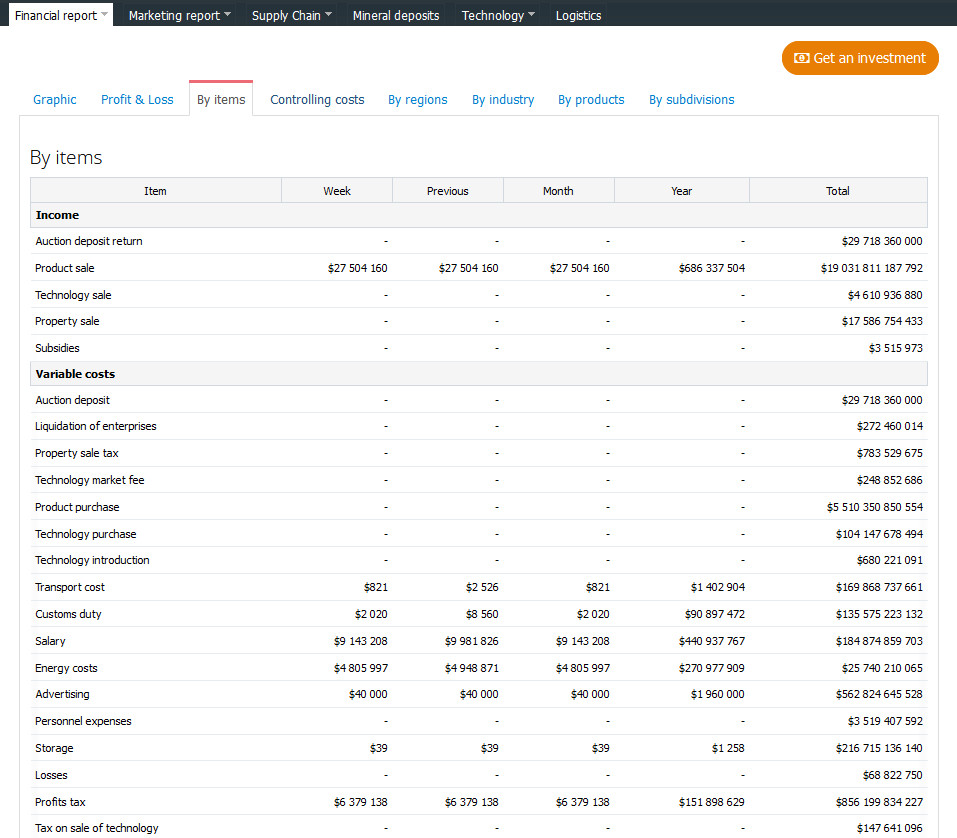
A sample of warehouse report: locations, sizes, supply, occupancy:
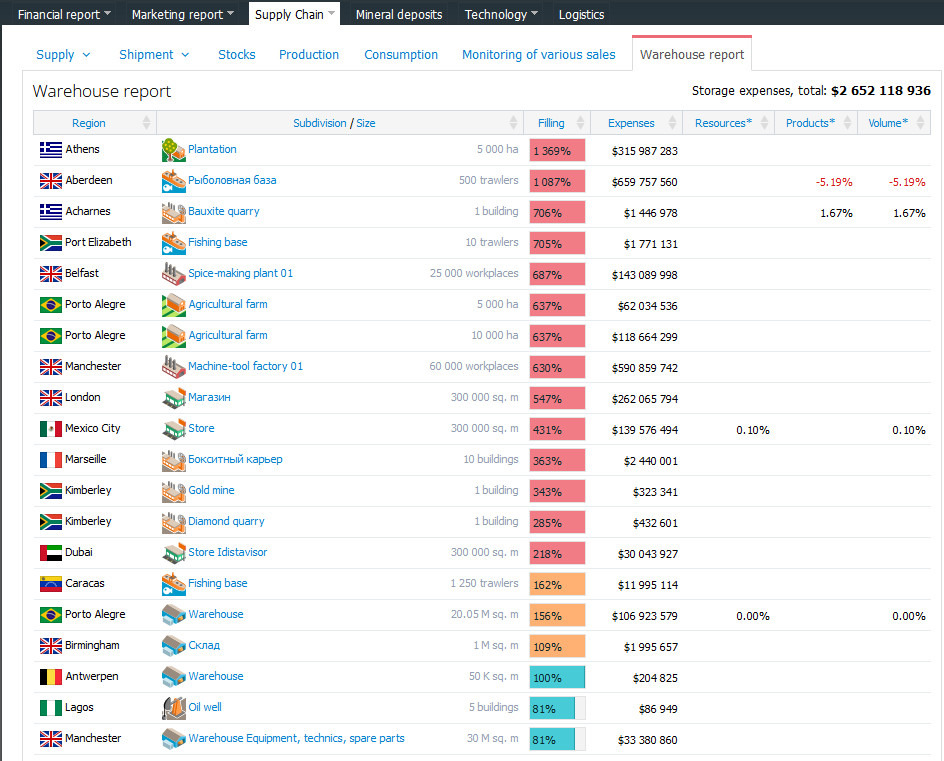
 Business games
Business games  Бизнес игры
Бизнес игры  Juegos de negocios
Juegos de negocios  Geschäftsspiele
Geschäftsspiele  Jogos de negócios
Jogos de negócios  Giochi aziendali
Giochi aziendali  Jeux d'entreprise
Jeux d'entreprise  Trò chơi kinh doanh
Trò chơi kinh doanh  ألعاب الأعمال
ألعاب الأعمال  Επιχειρηματικά παιχνίδια
Επιχειρηματικά παιχνίδια  Forretningsspil
Forretningsspil  משחקי עסקים
משחקי עסקים  商业游戏
商业游戏  비즈니스 게임
비즈니스 게임  Permainan perniagaan
Permainan perniagaan  Zakelijke spellen
Zakelijke spellen  Forretningsspill
Forretningsspill  Gry biznesowe
Gry biznesowe  Jocuri de afaceri
Jocuri de afaceri  İş oyunları
İş oyunları  Liiketoimintapelit
Liiketoimintapelit  Obchodní hry
Obchodní hry  Affärsspel
Affärsspel  ビジネスゲーム
ビジネスゲーム